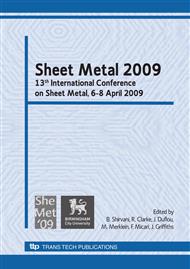p.87
p.97
p.105
p.117
p.127
p.143
p.151
p.159
p.169
Optimising the Design of Adhesively Bonded Joints
Abstract:
The effect of varying certain geometric and material property parameter on the stiffness of bonded joints has been investigated for both single overlap joints and for coach (T peel) joints. An understanding of bonded joint behaviour under load has been gained from this parametric study and this insight has been used to fashion some design guidelines aimed at optimising these parameters to increase joint stiffness. To develop these design guidelines, laboratory tensile testing of single overlap joints and coach joints, manufactured from steel and aluminium and bonded with either an epoxide or a methacrylate adhesive, was utilised to establish joint stiffness. For single overlap joints, joint stiffness was found to be sensitive to changes in adherend thickness, adherend’s Young’s modulus, bondline thickness and overlap length but indifferent to changes in adhesive material properties, unsupported length and joint width. Coach joints, stiffness was found to be sensitive to changes in adherend material, adherend thickness, fill ratio and outer radius and adhesive material. It must be recognised that the Design of Experiments technique, used to analyse the coach joint samples may have masked some of the effects caused by changes to joint parameters.
Info:
Periodical:
Pages:
127-139
Citation:
Online since:
March 2009
Authors:
Price:
Сopyright:
© 2009 Trans Tech Publications Ltd. All Rights Reserved
Share:
Citation:


